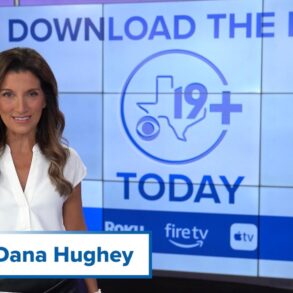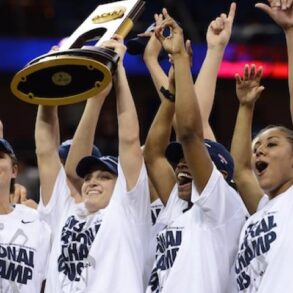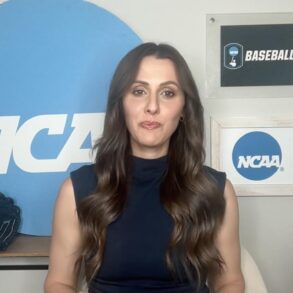
Michael Earley’s mind raced like a downhill truck without brakes in late June, each new thought an accelerant.
A 36-year-old who had just finished his third season as Texas A&M’s hitting coach, Earley felt optimistic regarding his chances of landing the Aggies’ head coaching job.
Earley was as familiar with the program as anyone, he reminded himself. He knew his players respected him and hoped that his passion for the university, which in 2022 gave him just his second coaching job, was apparent to its movers and shakers.
“Would it be enough, though?” Earley wondered.
Without any head coaching experience, he questioned whether others viewed his candidacy as strongly as he did. After all, Texas A&M was a powerhouse on the rise. It had reached the College World Series twice in a three-year stretch, including a CWS runner-up finish in 2024.
Spending money on a splash hire seemed like the obvious path, if not an inevitability.
But Earley didn’t have time to ponder his odds. Any time not spent on preparing to be the head coach could have proven costly in the event he was awarded the position.
So Earley sat down and did what he always did: He studied and prepared.
The result was a list.
“Step one: player retention,” his notes read. “Bring our talent back to Texas A&M. You don’t ever want to be the coach who lost Jace LaViolette or Gavin Grahovac or Ryan Prager or any of our talented guys, right?
“Step two: Call every high school recruit currently committed to the Aggies and keep them that way.
“Step three: Complete the roster with the (transfer) portal.
“And step four is you start the process of competing to win a championship.”
Earley was awarded the job the morning after fashioning his battle plan.
Staying true to the guide, he returned center fielder LaViolette, the College Player of the Year favorite this year; lefthander Prager, a 2024 third-round pick; third baseman Grahovac, the 2024 Southeastern Conference freshman of the year, and several others who filled key roles for the Aggies a year ago.
Earley also brought in seven top 100 transfers, patching potential holes with some of the best, most-experienced options available.
Anything less would have fallen short of his own expectations and increased the chances that the Aggies would fall flat in their first season under Earley’s direction.
Earley said he needed to assemble a group that would be primed to compete in a college baseball field that is as well-stocked with talent as ever.
“There’s no question about it,” Earley said when asked about the state of Division I baseball. “You look around and there’s no weekends off in the SEC—really anywhere. The players are just so good now.”
It came as somewhat of a surprise when Prager, a 6-foot-3 lefthander, turned down the Angels after he was picked in the third round in 2024 so that he could return to College Station for a fourth season.
Prager was coming off a career year, which saw him post a 2.95 ERA with 124 strikeouts against just 20 walks in 97.2 innings—loud results after he missed the entire 2023 campaign with an injury.
Prager said the decision effectively came down to one main element: Texas A&M’s potential as it sought to build off the roaring momentum from the previous season.
“There’s a buzz, an aura,” Prager said. “There are all these feelings that are positive and some of them started up last year, I’d say. It was a feeling of, ‘This season’s special,’ and I started to notice it at first with the crowd.
“The crowds all year, even on Tuesday, were packed more than they had been in previous years that I was here. That whole buzz around everybody stayed (and) then amplified. Everybody I’ve talked to is excited for baseball to come back to College Station.”
And for good reason.
If everything goes perfectly, the Aggies could have multiple all-conference honorees, All-Americans and early-round draft selections, a blend they’re confident could lead them back to the championship series.
“I don’t think anybody here is going to say that we don’t have belief that we can do it,” LaViolette said.
While Texas A&M might have more than most, high-caliber players are spread across the country this season. Not just in College Station or in the footprint of the SEC and Atlantic Coast Conference.
Three of Baseball America’s top 30 prospects for the 2025 draft play for mid-major programs, including UC Santa Barbara righthander Tyler Bremner, who could push to go first overall.
MLB scouting departments, who select our Preseason All-America Teams, picked six mid-major players in 2025, led by Bremner on the first team. In addition are Grand Canyon first baseman Zach Yorke and UNC Wilmington two-way player Tanner Thach on the second team.
Coastal Carolina catcher Caden Bodine, UC Irvine first baseman Anthony Martinez and Cal Baptist outfielder Nick Dumesnil are all third-teamers.
“You’re getting there on a Friday night and you’re going to be facing 96-98 (mph), maybe even 99 or 100,” LaViolette said. “That’s a given. Knowing you’re going to face someone in the upper (90s) every day just goes to show you how good college baseball has become. You get a different perspective on the game.
“This game’s really hard, and you learn how to deal with failure a little better.”
The surging amount of talent in college baseball is perhaps best demonstrated by its alumni, whose climbs to the major leagues are unfolding faster than ever.
In the 2023 and 2024 MLB seasons, a total of 50 former D-I players made their debuts within two seasons of their draft year.
The list includes many first-round picks from the 2023 draft, including LSU phenom Paul Skenes (Pirates), LSU outfielder Dylan Crews (Nationals), Florida outfielder Wyatt Langford (Rangers), Grand Canyon shortstop Jacob Wilson (Athletics), Wake Forest righthander Rhett Lowder (Reds) and Florida righthander Hurston Waldrep (Braves), who made their inaugural major league appearances in their first full professional season.
Former Florida Atlantic first baseman Nolan Schanuel debuted with the Angels in his draft season.
Over the six seasons prior—2017 to 2022—a total of 51 former D-I players were able to match that ascent.
College coaches today point to the development their programs can offer and how that, too, has contributed to the large increase in the number of college players reaching the majors within two years of being drafted.
“I know a lot of (major league) GMs who would tell you that we’re doing it as good as pro ball is doing it,” Mississippi State head coach Chris Lemonis said.
“You come to Mississippi State and you’re playing in a Double-A park with a weight room and a staff, mental health training to help handle the pressure, all these pieces—and we haven’t even talked about baseball yet. Our teachers even.
“There are a lot of great teachers in pro baseball, but think about the attention you get here.”
SEC coaches have seen the talent more than any other conference and are hardly surprised when those players go on to have resounding success in short order.
Simply put, there’s more ready-to-go talent in college baseball than ever before.
“It was pretty apparent in 2023 in Omaha,” said LSU head coach Jay Johnson, whose Tigers won it all that year. “On our team, you’re looking at Paul Skenes, Dylan Crews, and we’re facing Rhett Lowder—who’s already in the big leagues—Hurston Waldrep and Wyatt Langford, who are in the big leagues.
“When we were playing teams in Omaha, there were always like seven guys on the field who were going to play in the majors.”
High-major coaches and athletic directors don’t see an end to the talent boom in sight. Name, image and likeness rights and revenue sharing should only serve to reinforce prospects’ decisions to forgo an early start to their professional careers and steer them toward college baseball.
Another significant selling point is the recent trend of MLB organizations fast-tracking prospects through the minor leagues, which could lead to more sizable paydays more quickly.
“I’m a huge fan of professional baseball,” Clemson head coach Erik Bakich said. “Never against professional baseball, and I want every one of our players to play professional baseball.
“But I know for a fact that college baseball is a great farm system and a great opportunity for kids who need or want a few more years to play in a high-level environment with great facilities, amenities and resources and be ready to maximize their opportunity the next go-around with the draft.”
NIL, constantly shifting legislation and upcoming roster limits are some factors on the horizon that give college coaches pause when evaluating the state of their sport.
“There’s no sugar-coating it anymore,” one mid-major coach said. “There are a lot of questions about where we’re headed, especially outside of the power conferences.”
But even the program leaders whose futures might appear more unstable in this harsh climate would tell you that the overall trajectory is positive.
The game’s viewership hit all-time highs in super regionals and the College World Series last season, mid- and low-major schools have proven annually that they’re capable of making runs in the NCAA Tournament and the quality of play, they say, has never been better.
“It’s a great time to be a part of the sport,” South Carolina head coach Paul Mainieri said after unretiring to take the helm in Columbia.
“Being away from the sport and seeing just how great it had become made it hard to stay away.”
That product should be on full display in 2025.
“We can’t wait to compete this year,” Earley said. “We’re excited about what we have going on here, and that’s what we’re focused on, but the sport has never been better, too.
“Everyone wins this way.”
This post was originally published on this site be sure to check out more of their content.





